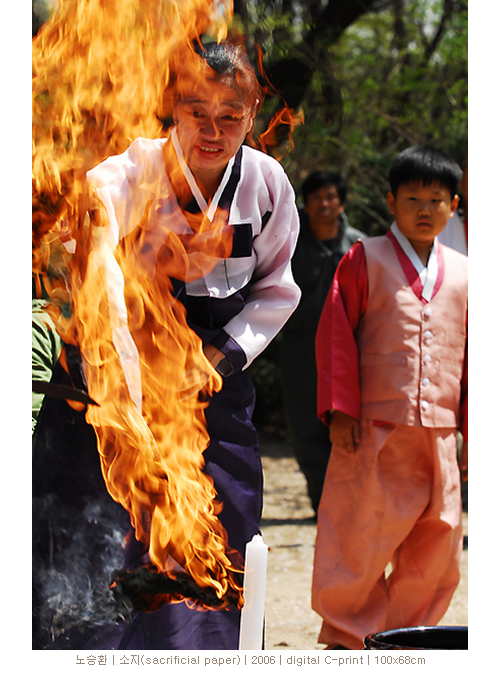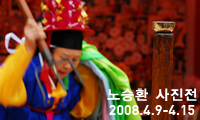상세정보
노승환 사진전
낯선슬픔 Unfamiliar Grief
불꽃처럼, 바람처럼, 운명처럼김중산 | 갈렙의학문화연구소장, 의사, 심리학자
사진이 온통 붉은 색 천지다. 배경도 주인공도 피사체(被寫體) 모두가 붉다. 작가는 무당이 입고 있는 청, 적, 황, 백, 흑의 오방색(五方色) 의상조차도 붉게 찍어냈다. 원초적인 생명의 힘이 강렬하게 온 몸으로 엄습해온다. 마치 장예모(張藝謨, Zhang Yimou)감독의 영화
붉은 수수밭(紅高梁, Red Sorghum)이나
홍등(大紅燈籠高高掛, Raise The Red Lantern)의 스틸 사진을 보는 듯한 착각을 일으킬 정도다.
피는 붉다. 피는 생명이다. 영원함이다. 강함이다. 근원적 에너지인 붉은 태양을 닮았다. 희생제물(Scape goat)로 오른 황소는 선혈(鮮血)이 낭자하다. 소의 피를 먹는 무당의 얼굴도 붉다. 그녀가 흘리는 눈물방울조차 붉어 보인다. 무당은 하늘에 제물로 바친 황소의 피를 먹음으로써 천지신명에게 대신 죄사함을 받아내려는 것일까?
무당이 지핀 불꽃이 이글거리며 타오른다. 불꽃도 붉다. 하늘에 제사할 희생제물을 삶고 요리하던 그 불꽃이 이제는 하늘로 훨훨 날아오른다. 이 한 많은 이승을 떠나 광명(光明)한 저 세상으로 간다. 불꽃은 제물 하나하나에 담긴 메시지를 무당을 대신하여 저 세상에 오롯이 전할 것처럼 타오른다. 그 메시지는 무당의 굿거리에 의하여 이미 정화(淨化)되었을 것이다. 이를 방증(傍證)이라도 하듯 작가의 앵글은 불꽃을 태우는 무당의 옆에 서있는 천진난만(天眞爛漫)한 어린 소년을 놓치지 않는다.

무당은 본디 이승과 저승의 중개자다. 분석심리학의 창시자인 칼 융(C. G. Jung)이 생전에
큰 무당 Great Shaman 으로 불린 것도 본질적으로 동일한 맥락이다. 융이 인간의 정신을 탐구하는 자세 역시 샤만들이 그러한 것처럼 이승에서 저승을 향했던 것이다. 융에게 저승은 인간의 무의식 세계를 상징했다. 무당은 인간을 대신하여 신과 직접 교통하고 교섭한다. 그녀는 춤을 춘다. 춤을 추면서 그녀는 그녀의 신을 놀라게도 하고 즐겁게도 하고 달래기도 한다. 그녀는 장군의 옷을 입고 칼과 창의 무기를 들고 악귀(惡鬼)를 쫓는 춤을 춘다. 작가의 사진 속에서 방울은 그냥 무당의 손에 들려있는 것 같지만, 악신을 쫓는 방울 소리와 북소리와 장구 소리가 사진을 보는 이들의 귀를 쩌렁쩌렁 울려나오는 듯하다. 그녀가 휘두르는 칼과 창에 잡귀들이 혼비백산 놀라 도망갈 것 같다. 악귀를 내쫓는 용감무쌍한 그녀는 화면의 중심을 차지한다. 아이러니하게 21세기의 무당은 칼과 창뿐만 아니라 기관총까지 들고 나타난다. 그러나 우리는 그 장면이 하나도 우습지 않다. 오히려 슬프다.
그녀가 하늘을 향해 힘차게 내뻗은 오방색 천이 허공을 휘익 휘젓고 돌아온다. 그녀의 신을 위무(慰撫)하는 것이 그녀의 임무다. 그녀의 기구한 현세의 팔자 혹은 운명은 그녀를 무당으로 내몰았다. 그 운명은 거부할 수도 없었다. 그렇다고 선택할 수 있는 것도 아니었다. 희랍신화의 시지프스(Sisyphus)의 운명 같은 그녀의 운명은 고래의 뱃속에 삼켜졌다가 살아난 구약성경의 요나(Jonah)에도 비할 바 없이 가혹하다. 그럼에도 불구하고 춤추는(舞) 그녀는 비워지지 않는 자신을 비워야(無)한다. 그래서 작가는 하늘을 향해 내던진 오방색 천의 다이내믹을 사진의 중심에 두고, 슬픈 운명의 무당얼굴을 슬그머니 오른 쪽 구석으로 밀어낸다.

그녀는 외친다. “신도 싫고, 인간도 싫다! 그래 또 울고 가자!” 그러나 비우겠다고 해서 비워진다면 운명이 아니지 않은가. 그녀의 신이 굿판에 강림(降臨)하면 신령한 능력을 얻기 위해 그녀는 그녀의 수호신에 몸을 의탁한다. 그녀의 보호신에 빙의(憑依)한 그녀는 드디어 맨 발로 작두를 탄다. 잠시라도 방심하면 그대로 목숨을 앗아갈 것 같은 작두 위에서 그녀는 망아(忘我)가 된다. 그녀의 신에 몸을 실었으니 이제는 그녀가 신이다. 무아지경의 엑스터시(Ecstasy) 속에서 그녀는 신이 되어 작두 날 위에서 춤을 춘다. 그러나 개선장군 같은 화려한 춤을 추던 그녀의 황홀한 엑스터시의 파티도 때가 되면 끝내야한다. 미지의 심연같은 무의식의 세계로의 여행을 끝내고 의식의 세계로 귀환하지 않으면 안된다.
파티가 끝나면 주인공도 관객도 다 떠나가고 그녀는 또 다시 비루하고 남루하고 기구한 현실로 돌아와야 한다. 더구나 그녀의 굿판은 황홀하되 그 굿판은 공연이 아니다. 그녀는 스포트라이트를 받는 프리마 돈나는 더더욱 아니다. 그녀의 삶은 공연이나 드라마가 아니라 어떻게든 살아내어야만 하는 가시밭길 같은 현실이다. 호탕하게 웃는가 싶더니, 비장하고 광기어린 매서운 눈매를 보이다가도, 이내 눈물을 펑펑 쏟고 마는 그녀에게서 우리는 그녀의 이승을 본능적으로 읽는다. 우리는 작가가 굳이 카메라에 담지 않은
낯선 슬픔 그 너머의, 그녀가 어디 마음 둘 곳 하나 없는 신산(辛酸)한 현실을 알고 있다.
 Like Flame, Like Wind, Like Fate
Like Flame, Like Wind, Like FateKIM JOONG SAN
The pictures are full of the color of red. The background, the main cast, all are red. The photographer had even depicted the medium's five-colored garments red. The raw power of live overwhelms the viewer. It is not unlike the scenes in Zhang Yimou's filmography, such as Red Sorghum, or Raise the Red Lantern.
Blood is red. Blood is life. Eternity. Strength. It resembles redness of the sun, which is the core energy. The sacrificial bull is red with its own blood. The medium who eats the blood is also red. Her tears also seem red. Is she trying to win the heaven's favor, by drinking the blood of the sacrifice?
The flame which she lit burns upwards. The fire also is red. The fire that was used to cook and burn the sacrifice now soar upward. The soul leaves this sorrowful earth, to reach heavens. The message is cleansed by the medium's rituals. As if to tell us that, the photographer does not miss the innocent young boy standing right beside the medium.
The medium is the communicator between this world and the afterlife. Carl Jung was called the
in that context. Just like shamans did, he searched the human mind in relation to the path between the world and the afterlife. For Jung, the afterlife represented the unconscious.
The medium talks with gods in our place. She dances. She surprises her god, pleases and appeases the god in doing that.

She dances the dance of exorcism, chasing demons wearing general's garments and holding a sword, a spear. The bells seem to just be in the medium's hand, but when it rings, it emits the terrible sound that rings the years of the viewer. She brandishes her blades, which makes the demons run in fear. Ironically, the medium of the 21th Century holds machine guns. But we don't think it's funny. It's rather sad.
The five-colored cloth that she threw comes back through the air. It is her duty to please her god. Her inevitable fate led her to become a medium. She never had a choice in that. It is at least as cruel as Jonah, who was swallowed by a whale, or Sisyphus.
Nonetheless, she, the medium and the dancer, had to empty herself who was not to be emptied. That's why the photographer puts the five-colored cloth into the center of the picture, while the medium's sordid face is down at one corner. She cries: "I hate gods! I hate humans! Yes, I will cry out again!"

But it is never fate, if she could empty it out when she wants to empty it out. She gives her body up to her god. The god rides him, and she rides the blades, barefeet. She is the god now, as the god rides her. She dances as a god, in her ecstatic glee.
But the party must end, and so does her fiery dance of a victor. The trip to the bottom of the unconscious is ended, and she must thus return to the world of the consciousness.
When the party's over, the main cast has to live, the audience has to live, and she has to return to her less than fulfilled life. Her stage is glorious, but that's not a performance by any standard means. She could never be a prima donna in her spotlight. Her life is not a performance, rather a thorny pass she has to go right through.
We read the pages of her live, as she bursts out of laughter, show sharp and grave eyes, and then cries her eyes out. We all know the reality over "Unfamiliar grief," where she doesn't have anywhere to ease her mind.
스페이스아침
10:00am~06:00pm
Tel 02.723.1002
서울 종로구 화동 138-7
www.mooze.co.kr






